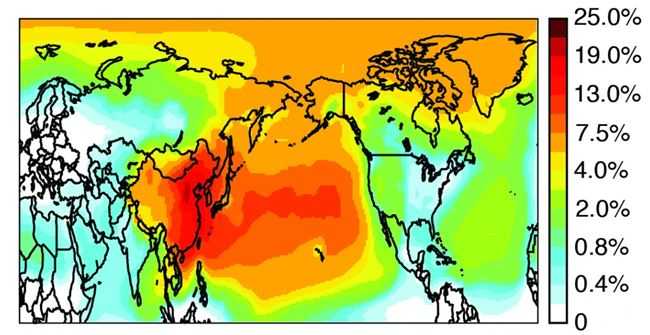When Chinese exports to the US and Europe rise, so do levels of pollution that blow across the Pacific Ocean, researchers from the University of California-Irvine reported in the journal Proceedings of the National Academy of Sciences.
The authors say theirs is the first study to quantify how much pollution reaches the American West Coast as a result of industrial activity in China dedicated to exports.
Co-author, Steve Davis, an UC Irvine Earth system scientist, said:
“We’ve outsourced our manufacturing and much of our pollution, but some of it is blowing back across the Pacific to haunt us. Given the complaints about how Chinese pollution is corrupting other countries’ air, this paper shows that there may be plenty of blame to go around.”
The analysis found that Los Angeles gets at least one extra smog day per year that exceeds federal zone limits because of carbon monoxide and nitrogen oxides coming from Chinese factories that make goods for exportation.
On some days, up to one quarter of the US West Coast’s sulfate pollution is linked to Chinese exports. The scientists say that all the contaminants identified in the study are key ingredients in the smog and soot that are known to be bad for human health.
Most of the pollution found in the US comes from cars, trucks and refineries in America. However, ‘westerlies’ – powerful global winds – can carry chemicals in the air across the ocean in a matter of days, especially during the spring.
Westerlies definitely contribute to the dangerous spikes in contaminants. Carbon, ozone and dust can build up within the valleys and basins in the Western states.
Black carbon travels long distances
Black carbon is a major problem because it does not get washed out easily by rain, so it persists and travels long distances as an airborne particle.
Black carbon has been associated with a range of health problems, including heart diseases, lung disease, asthma, emphysema and cancer.
Annual average percent of black carbon pollution related to Chinese exports (Source: UC California-Irvine).
The authors believe their study findings could be useful for negotiators when discussing clean-air treaties.
Chinese industry has grown considerably over the last three decades, and so has pollution. Industrial growth combined with poor pollution controls is a deadly mix which “has unleashed often fierce international debates.”
The product might not contain pollution, but making it causes pollution
Davis noted:
“When you buy a product at Wal-Mart, it has to be manufactured somewhere. The product doesn’t contain the pollution, but creating it caused the pollution.”
The researchers conclude:
“International cooperation to reduce transboundary transport of air pollution must confront the question of who is responsible for emissions in one country during production of goods to support consumption in another.”

